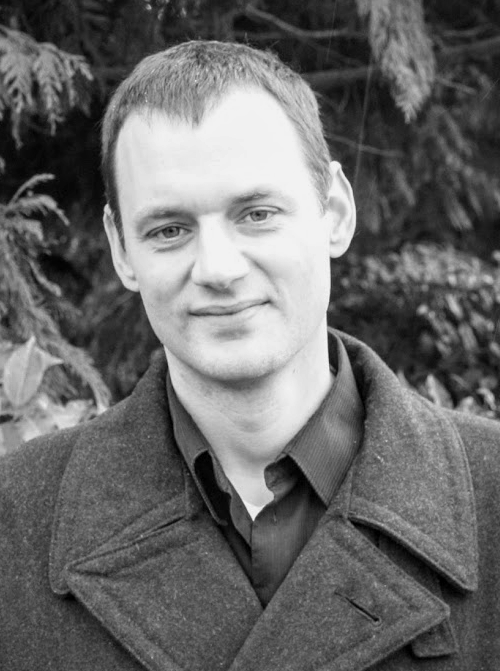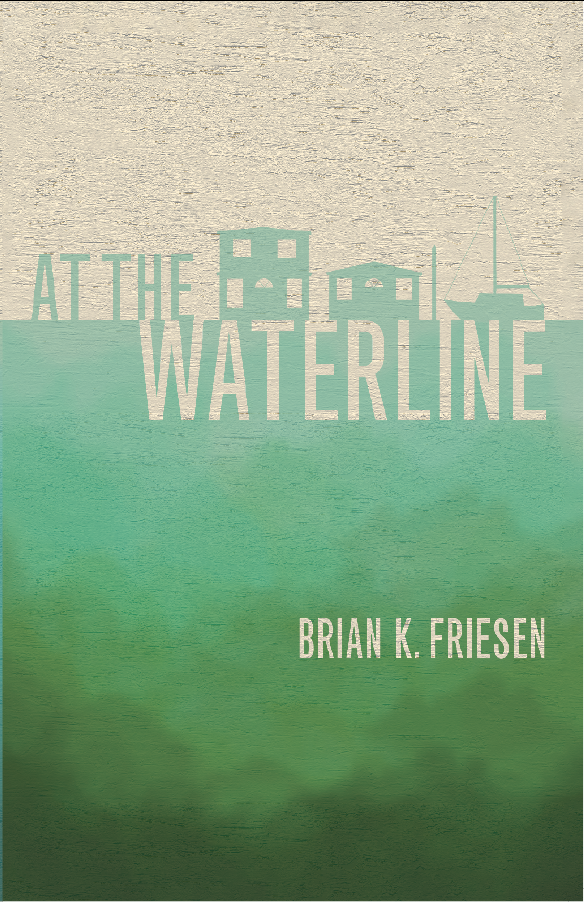Brian K. Friesen


Brian K. Friesen’s debut novel At the Waterline offers a remarkable look at Oregon waterways. In it, Friesen dives head first into The Columbia and Willamette Rivers, surfacing a beautiful story contextualizing the complex cultural currents along their shores. The characters he imagines–or the people informing his work–possess as much depth as the water flowing throughout the novel’s pages. Entangling their storylines is a series of lost faith, failed love, hot dogs and death that all collects at a fictional marina outside of Portland, where Friesen’s characters find sanctuary.
While Friesen’s own experiences living on a boat along local riverways inform At the Waterline, his fictionalization of those occurrences characterize his story even deeper. The result is one that finds Friesen succeeding at delivering a confident, tightly threaded, at times humorous and heartfelt debut novel appreciating the rivers he clearly admires and respects.
Eleven: At the Waterline centers on the Columbia and Willamette rivers, which are two waterways you know quite well. Can you talk about your own history with the book’s setting?
Brian K. Friesen: So much of my life–since about 1985–has been lived in this corner of Oregon, where the land tilts toward the Columbia River and gravity pulls water into the Willamette and Columbia watersheds. As a young adult, ever since I could drive myself places, I would go down to the river as often as I could. You see such a tiny percentage of the river when you “view” it from a car window, or in photographs. But the more I crawled along those shores, the more fascinating those rivers became. I began to appreciate the beauty and power of the often smelly, unphotographable shores. While on the water, I had this childlike sense of getting away with something in such a vast landscape that felt liberating. That was the first thing that materialized in the first drafts of At the Waterline. And that was the place I wanted to capture in the novel.
11: How did your personal experiences on Oregon’s rivers inform the content of the book?
BF: My own personal experiences are where I started when I began to write the first drafts of the book. My experience roughly follows the main protagonist in the novel: I lived on a sailboat for several years near Jantzen Beach. I took sailing courses, and I helped teach them for a short while. I worked odd jobs at marinas on the Columbia River, and on the Multnomah Channel between Sauvie Island and the Oregon mainland. I clumsily bumbled my way into figuring out what to do and not do on the water. I ran my sailboat into things. I got towed back to a marina by the Coast Guard once. I learned a lot of stuff the hard way.
Some of the people I knew on the water informed the characters in the book. The people who lived on the water who–unlike my younger self–seemed to know what they were doing. That was probably the next big thing to influence my writing: The people.
11: At the Waterline began as a collection of nonfiction and fiction essays. Can you elaborate on your writing process?
BF: Right. At first, I was writing short creative nonfiction essays heavily focused on the setting and the people I came to know. At first, I had too much on my mind about what I wanted to say. I was probably more interested in writing reportage pieces about the people who live on the river. Personal interest stories, maybe, that I could try to get published somewhere. I was self-consciously trying to architect what I thought good literary nonfiction was supposed to be.
11: And collectively, it’s now fiction.
BF: With several years of overly self-conscious study into the artifice of nonfictional essays, I found fiction to be extremely freeing, so I kept going. The temptation for me now is to dance the reformed literary-fiction dance. It is just as easy to lose sight of the art of fiction by over-refining a story until the artifice of the literary form overwhelms the reader’s ability to get lost in the story.
11: How did you approach fictionalizing the nonfiction pieces?
BF: Maybe my saying that it started out as nonfiction was a little misleading. I was trying to find a way to write about real people, but I couldn’t find a way in. I’d written nebulous essays about the river setting, but I got lost when I tried to place people in that setting to tell a compelling story about them. So on a whim, I thought I would try to take a couple of the nonfiction characters I had, and place them into a fictional setting. Then I tried dialing back on the fictional aspects of these characters, while staying within the realm of creative nonfiction. At that point, the characters were already taking on their own lives, so their stories began to weave into one another. I guess my own experience might show that one way to write fiction is to try hard not to write fiction.

11: Can you talk more about the fictionalization of people you know?
BF: There are a couple of characters that reflect real people I knew, but the motivations and decisions of the fictional characters are unrecognizably unique. Of the characters in At the Waterline, Dory is the one who most closely resembles an actual person I knew. Someone who ran a hot dog stand on a dock somewhere along the Columbia River basin. The character Jack, however, is an amalgamation of a couple different people. And yet, Jack’s character is a force of fictional nature that wouldn’t stand for being pinned down as being merely this guy I used to know.
11: What’s pulling your characters into the currents of the river?
BF: The river seems like an endless source of metaphors. The past is always moving by. And the future. Shifting memories. Missed opportunities. That’s one thing I love about the setting: the river is always underfoot, giving the illusion of movement.
For a character like Dory, the river is like the social current at the marina. She’s like a river herself, giving and receiving gossip, counsel and comfort. She’s unavoidable. She is oblivious about certain little things that are obvious to the reader, but you wouldn’t write her off entirely. The main character, Chad, on the other hand, goes back to the river (if slowly) to face his past. Maybe he is young enough that he doesn’t know exactly what he’s doing. His curiosity about people and about his own experience may be a saving grace, or it may get him killed. There is courage there (and naivety) that Chad doesn’t recognize, but I think Jack eventually does.
11: Your book captures this amazing counterculture existing along Portland’s waterways. What was marina life like?
BF: The marina in the novel is very much a crux for the difference in cultures, character motivations and passions. There is a lot of push and pull between sailors and power boaters. That aside, one person might urinate over the side of their boat into the river, much to the horror of those who take their refuse to the treatment plant. The gregarious characters might also share space with the introverted, evasive characters. So if you walk down the thin rows on the dock where there’s barely any room, and pass by someone going the opposite way, your arms will brush. And if there’s a shared history between those swinging arms–look out! The setting is great for bringing out these disparate characters together, often at cross-purposes.
11: How did you approach writing those cultural differences?
BF: While writing cultural differences is fascinating, I didn’t want them to be there for their own sake. I wanted any writing about those differences to fuel character exploration. You might look at a character like Barry, who lives on his sailboat, eats fish, and drinks alcohol incessantly, and you might say that he’s living a form of homelessness. Then you put him on a yacht with a large family, have them share a thanksgiving dinner, and suddenly this ex-catholic priest is interacting with the children of a rich family and stunning things happen.
If you hover over the surface of these kinds of interactions, you might come to the convenient social conclusions about priests and children, or rich and poor people. I’ve hopefully written my way under the skin of the characters in that situation in a way that enables readers to engage with everyone at some level. It’s what I want most from fiction: The ability to give a compassionate reading to every character making their way through the story.
11: Your book gives one the best portraits of the Columbia River and Willamette River. How did writing At the Waterline inform your understanding of those rivers?
BF: I definitely grew to love and respect Pacific Northwestern rivers more in the process of writing this novel. And I learned about the Anglo-centric narrative of the Columbia and the older histories of the river while writing. I also read and researched Celilo Falls and the loss of that important cultural place as well. However, I’m no less curious or fascinated about the Columbia after writing this than I was before. I like this river. I want to get to know it more.
Affection and respect for a place are important to nurture. Society needs that–all levels of society. If we are going to find our way to a healthy state somewhere between caring for our rivers and managing them, cultivating affection and respect have to be part of that. »



